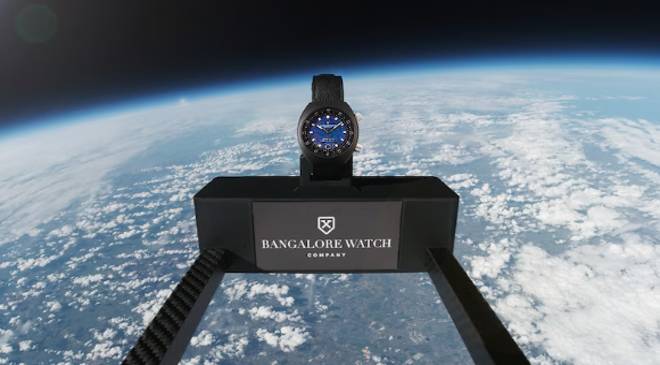Bangalore Watch Company has announced the successful testing of its Apogee wristwatch in space. The prototype, part of the Apogee collection, undertook a stratospheric flight, reaching an altitude of 1,14,000 feet (35 kilometres) and returning intact to Earth.
The meticulously planned Karman Line Project spanned two years, combining technical precision with innovative design.
Read More: Amazon launches online shopping service in South Africa
The Apogee Karman Line watch, commemorating this milestone, boasts a blue-coloured Muonionalusta meteorite dial, sourced from a meteorite recovered in Sweden and known to predate Earth. With only 50 limited-edition pieces available, each watch promises exclusivity and a tangible connection to space exploration. The spaceflight, documented by 4K cameras, showcased the Apogee’s flawless performance amidst adverse conditions.
Here’s a quick conversation about the space-faring watch with Nirupesh Joshi, co-founder and creative director of Bangalore Watch Company.
PD: What is the story of the Apogee Karman Line watch?
Nirupesh Joshi: For the past three-years, the Apogee collection has seen many iterations. There are 100s of Apogee watch owners who wear the watches proudly, telling the story of the Indian space program, making it a conversation piece. The watch has now taken on the moniker of “The Indian Space Watch”.
In the past 18 months, we have been engaged on a secret project with a goal of moving the Apogee from being a space-inspired watch, to an actual space-qualified watch. Building a watch that is qualified for space is no mean feat, and we’re very proud of being able to achieve this.
The Karman Line is a set of 50 limited-edition watches that are built exactly like the watch that made the journey to Space. This is a celebration of what we believe to be a critical milestone in our brand’s journey.
Besides the story, the watch is special too – it gives 50 of our future watch owners the exclusive opportunity to wear a watch imagined and built in India, qualified for Space, carrying a rare blue outer-space Meteorite. This is an exotic watch that is sure to become a conversation piece!

PD: Can watches survive in space? What happens to watches in space?
Nirupesh Joshi: In general, wristwatches can survive in Space – there are no known problems with the timekeeping functions of a watch in Space. However, there are two challenges:
First, to get to Space (and return to Earth), rockets and spacecraft travel at incredible speeds. At these speeds, you’re dealing with shock and temperature fluctuations. So, a watch must be built to be able to handle these conditions.
Second, most watches worn in Space are used in pressurised environments – inside the space station, or a spacecraft. The stress on a watch isn’t abnormal in these environments. However, few watches have been worn outside the pressurised environments – during spacewalks where the watches are exposed to extreme temperatures and complete vacuum. These watches must be built to withstand the extremities of Outer Space. If not, they will fail as a fundamental
timekeeping tool during space missions.
PD: Can you share details about the Spaceflight?
Read More: PhonePe offers cashback for Akshaya Tritiya 2024: Get up to Rs 2,000 on digital gold purchases
Nirupesh Joshi: In early 2024, a customised carbon-fibre spacecraft was launched into Space. The craft was only 2 kg in weight and carried a purpose-built Apogee wristwatch. The spacecraft was lifted into the atmosphere by a hydrogen-filled high-altitude balloon. During a four-hour Spaceflight, the balloon went up to a peak altitude of 114,000 feet – this is a Stratospheric flight almost four times higher than the height of Mount Everest, and three times higher than the height of commercial planes. The temperature dropped to –60 degrees Celsius within a short time, there was no oxygen, and no atmosphere at this altitude. Notably, the Apogee was not held in the craft inside a pressurised capsule, but rather suspended in Space outside the craft exposed to the extremities of Space.
After a brief period in Space, the high-altitude balloon was remotely deflated, forcing the craft to fall back into Earth’s gravity, free-falling at almost 350 kmph. As the craft (and the watch) approached Earth, a drogue parachute was deployed to slow down the rapid speed. With the help of the parachute, the spacecraft safely touched down on Earth carrying the watch back to safety.
Throughout the four-hour spaceflight, several 4K cameras recorded the watch. We are proud to say that the watch worked flawlessly throughout the flight with no visible timekeeping issues, condensation, or other issues despite the extreme pressure and temperature changes that the watch was exposed to. Bangalore Watch Company worked with a space-engineering company in the UK to plan and execute the spaceflight.
PD: Was the Apogee custom-built for the Spaceflight? What tests were performed?
Nirupesh Joshi: All Bangalore Watch CompanyTM watches go through rigorous testing standards that meet the Swiss NIHS specifications for how high-quality watches should be built. As part of the testing and quality control, all our watches go through pressure testing that guarantees that the watches perform under pressure of 100 meters of water.
For the Karman Line spaceflight, two watches were specially designed, built, and put through a more rigorous test routine that consisted of (1) testing not only in excess pressure, but negative atmospheric pressure – this is because there is only vacuum in Space, and (2) testing the watches in freezers that went to –30 degrees Celsius.
The combination of pressure and temperature change tests allowed us to feel confident about sending the two prototypes to be qualified for Spaceflight.
PD: What is a Meteorite? Can you share details about the Meteorite in the Karman Line watch?
Nirupesh Joshi: Meteorites are space rocks that have fallen to Earth over thousands of years. The specific Meteorite of the Karman Line dial is from Muonionalusta, along the border of Sweden and Finland. Most Meteorites found on Earth such as the Muonionalusta, are ferrous (Iron-based).
We worked with Meteorite hunters to source pieces from the Muonionalusta meteorite. We then sent it to our manufacturing partners in Switzerland who cut the rock and processed it to our specifications to be used in our watch dials. Due to the rarity of this material and the challenges in manufacturing, we can only make small batches at a time.
The Karman Line carries a rare, Blue-plated meteorite that is reminiscent of the blue skies that the watch saw during its Spaceflight.

PD: Are you officially associated with the Indian Space Program?
Nirupesh Joshi: As an Indian brand, we take the liberty of using what is already available in the public domain and create world-class watches with designs that borrow from these stories. We do not use any information that is proprietary, or confidential in nature. We are not officially associated with the Indian space program.
Read More: 5G auction: Jio, Airtel, Vi in action
PD: Now that your watches are Space-qualified, will the Indian astronauts wear your watch?
Nirupesh Joshi: The Apogee is now a Space-qualified watch. The next milestone for this watch will be to get it human-rated. We will be proud to work with the Indian space program to develop a line of watches that are human-rated and can be worn on the wrists of astronauts. We hope that opportunity presents itself in the near future.





































